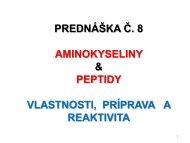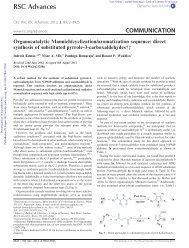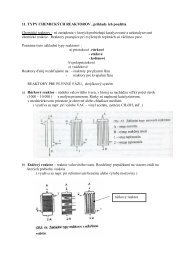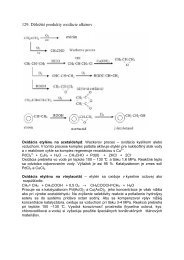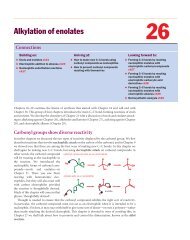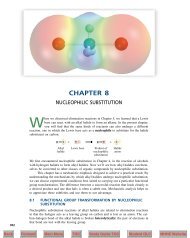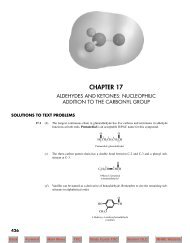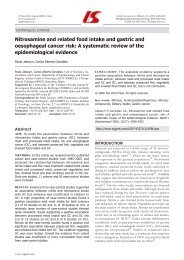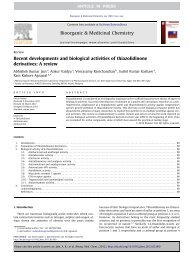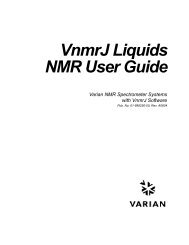Safe and Efficient Tetrazole Synthesis in a Continuous-Flow ...
Safe and Efficient Tetrazole Synthesis in a Continuous-Flow ...
Safe and Efficient Tetrazole Synthesis in a Continuous-Flow ...
Create successful ePaper yourself
Turn your PDF publications into a flip-book with our unique Google optimized e-Paper software.
Microreactors<br />
<strong>Safe</strong> <strong>and</strong> <strong>Efficient</strong> <strong>Tetrazole</strong> <strong>Synthesis</strong> <strong>in</strong> a Cont<strong>in</strong>uous-<strong>Flow</strong><br />
Microreactor**<br />
Prakash B. Palde <strong>and</strong> Timothy F. Jamison*<br />
<strong>Tetrazole</strong>s are an important class of heterocycles <strong>in</strong> a wide<br />
range of applications, such as, organocatalysis <strong>and</strong> transitionmetal<br />
catalysis, propellants, explosives, <strong>and</strong> perhaps most<br />
commonly, as non-classical isosteres of carboxylic acids <strong>in</strong><br />
medic<strong>in</strong>al chemistry. [1, 2] This broad utility has prompted<br />
significant effort toward tetrazole synthesis, [3] <strong>and</strong> notable<br />
among these is that of Sharpless, <strong>in</strong> which aqueous z<strong>in</strong>c<br />
bromide (ZnBr 2) facilitates the assembly of tetrazoles from<br />
nitriles <strong>and</strong> sodium azide (NaN 3). [3e] Nevertheless, the majority<br />
of reported methods are either less straightforward or<br />
generally not suited for large-scale synthesis; they require<br />
explosive <strong>and</strong>/or expensive reagents, toxic metal-conta<strong>in</strong><strong>in</strong>g<br />
compounds, or excess azide. The most significant hazard is the<br />
generation of hydrazoic acid (HN 3), particularly <strong>in</strong> reactions<br />
conducted <strong>in</strong> the presence of even trace amounts of Brønsted<br />
acids. [4]<br />
Cont<strong>in</strong>uous-flow synthesis is emerg<strong>in</strong>g as a powerful<br />
technology complementary <strong>in</strong> several contexts to batch<br />
synthesis <strong>in</strong> flasks or vessel reactors. [5] As only small<br />
quantities of reagents <strong>and</strong> products are exposed to the<br />
reaction conditions at a given time, the risks associated with<br />
hazardous materials are m<strong>in</strong>imized, <strong>and</strong> transformations<br />
us<strong>in</strong>g them are thus rendered much safer. <strong>Flow</strong> would thus<br />
appear to be an appropriate reaction format for the synthesis<br />
of tetrazoles from nitriles <strong>and</strong> an azide source. Dur<strong>in</strong>g the<br />
preparation of this manuscript a collaborative effort between<br />
Kappe <strong>and</strong> Lonza reported an exquisitely eng<strong>in</strong>eered system<br />
for the cont<strong>in</strong>uous-flow synthesis of tetrazoles us<strong>in</strong>g HN 3. [6]<br />
Generated <strong>in</strong> situ from NaN 3 <strong>and</strong> acetic acid, HN 3 (approximately<br />
2.5 equiv at 1.6m) may be used at elevated temperatures<br />
<strong>and</strong> pressures to prepare a range of tetrazoles from the<br />
correspond<strong>in</strong>g nitriles.<br />
From the outset of our <strong>in</strong>vestigations, described here<strong>in</strong>, we<br />
took a conceptually <strong>and</strong> technically different approach,<br />
establish<strong>in</strong>g the follow<strong>in</strong>g as fundamental requirements of<br />
[*] Dr. P. B. Palde, Prof. Dr. T. F. Jamison<br />
Department of Chemistry<br />
Massachusetts Institute of Technology<br />
Cambridge, MA 02139 (USA)<br />
Fax: (+ 1)617-324-0253<br />
E-mail: tfj@mit.edu<br />
Homepage: http://web.mit.edu/chemistry/jamison/<br />
[**] We are grateful to the Novartis-MIT Center for Cont<strong>in</strong>uous<br />
Manufactur<strong>in</strong>g for f<strong>in</strong>ancial support <strong>and</strong> to several colleagues at<br />
MIT (Stephen L. Buchwald, Klavs F. Jensen, <strong>and</strong> their co-workers)<br />
<strong>and</strong> Novartis (Gerhard Penn, Berthold Schenkel, Oljan Repic,<br />
Thierry Schlama, Mike Girgis, Lukas Padeste, <strong>and</strong> Felix Kollmer) for<br />
<strong>in</strong>sightful discussions.<br />
Support<strong>in</strong>g <strong>in</strong>formation for this article is available on the WWW<br />
under http://dx.doi.org/10.1002/anie.201006272.<br />
DOI: 10.1002/anie.201006272<br />
our method: avoid the use <strong>and</strong> generation of HN 3, [7] require<br />
only a slight excess of azide (<strong>in</strong> any form), develop a system<br />
that can be assembled easily such that it may be implemented<br />
both <strong>in</strong> the laboratory (education <strong>and</strong> research) <strong>and</strong>, with<br />
straightforward modification, on manufactur<strong>in</strong>g scale. In<br />
addition to be<strong>in</strong>g safer (no HN 3, m<strong>in</strong>imal azide usage),<br />
easily assembled (see video provided <strong>in</strong> Support<strong>in</strong>g Information)<br />
<strong>and</strong> less expensive (syr<strong>in</strong>ges, syr<strong>in</strong>ge pumps, oil bath,<br />
st<strong>and</strong>ard tub<strong>in</strong>g <strong>and</strong> fitt<strong>in</strong>gs), this method is, perhaps unexpectedly,<br />
faster <strong>and</strong> higher yield<strong>in</strong>g <strong>in</strong> many cases. Other<br />
features <strong>in</strong>clude the fact that neither a metal catalyst nor<br />
promoter is required <strong>and</strong> the <strong>in</strong>clusion of a simple <strong>in</strong>-l<strong>in</strong>e,<br />
post-reaction treatment with NaNO 2 to quench the vanish<strong>in</strong>gly<br />
small traces of rema<strong>in</strong><strong>in</strong>g azide.<br />
We began our <strong>in</strong>vestigations by evaluat<strong>in</strong>g several<br />
reported methods of tetrazole synthesis with the aim of<br />
f<strong>in</strong>d<strong>in</strong>g one that would be amenable to the requirements listed<br />
above. In early stages, small-scale microwave reactions<br />
provided a useful <strong>and</strong> <strong>in</strong>formative bridg<strong>in</strong>g basis of comparison<br />
between batch <strong>and</strong> flow [8] (Table S1, Support<strong>in</strong>g Information).<br />
Nitrile 1 (Figure 1, R = p-anisyl) was chosen as the<br />
start<strong>in</strong>g po<strong>in</strong>t as it is of moderate reactivity <strong>in</strong> most tetrazole<br />
syntheses, largely due to the electron-donat<strong>in</strong>g effect of the<br />
methoxy group. [9] The conditions reported by Sharpless<br />
et al. [3e] <strong>and</strong> later shown to be effective under microwave<br />
irradiation by Fang et al. [3h] (Table S1, entries 4–6) showed the<br />
greatest promise for development of a flow process. With<br />
nitrile 1 a reaction temperature of 1408C provided the highest<br />
Figure 1. A) Cont<strong>in</strong>uous-flow synthesis of tetrazoles us<strong>in</strong>g our microreactor.<br />
See Support<strong>in</strong>g Information for parts list <strong>and</strong> <strong>in</strong>structions for<br />
assembly <strong>and</strong> operation (video). B) Summary of the function of each<br />
reactor feature. NMP= N-methyl-2-pyrrolidone.<br />
Angew. Chem. Int. Ed. 2011, 50, 3525 –3528 2011 Wiley-VCH Verlag GmbH & Co. KGaA, We<strong>in</strong>heim<br />
3525
Communications<br />
yield of desired tetrazole 1a (65 %) <strong>in</strong> 30 m<strong>in</strong>. The solution<br />
mixture rema<strong>in</strong>ed homogenous throughout the entire course<br />
of the reaction, but an undesired byproduct, carboxamide 1b<br />
(see Support<strong>in</strong>g Information), result<strong>in</strong>g from nitrile hydration<br />
was also obta<strong>in</strong>ed <strong>in</strong> significant quantities (9% yield). [10]<br />
Nevertheless, this lead result served as the start<strong>in</strong>g po<strong>in</strong>t<br />
for the development of a straightforward flow process<br />
(Figure 1 <strong>and</strong> Table 1). Nitrile 1, NaN 3, <strong>and</strong> ZnBr 2 <strong>in</strong> a<br />
Table 1: Optimization of cont<strong>in</strong>uous-flow tetrazole synthesis. [a]<br />
Entry Solvent NaN3 ZnBr2 Conv. Yield [%] [b]<br />
(equiv) (equiv) [%] [b]<br />
1a 1b<br />
1 [c]<br />
THF:H2O (1:4) 4 2 90 76 10<br />
2 IPA:H2O (1:4) 4 2 79 64 11<br />
3 NMP:H2O (1:4) 4 2 95 83 8<br />
4 NMP:H2O (1:4) 2 1 81 72 7<br />
5 NMP:H2O (1:4) 1.05 0.5 61 56 4<br />
6 NMP:H2O (9:1) 1.05 0.5 63 61 < 1<br />
7 [d]<br />
NMP:H2O (9:1) 1.05 0.5 86 78 7<br />
8 [d]<br />
NMP:H2O (9:1) 1.05 0 83 81 < 1<br />
[a] See Support<strong>in</strong>g Information. Unless otherwise noted, substrate<br />
concentration [1] 0 = 0.2m; reaction temperature = 1908C; residence<br />
time (tr) = 20 m<strong>in</strong>. [b] Determ<strong>in</strong>ed by HPLC. [c] Reaction temperature =<br />
1708C. [d] [1] 0 = 0.4m; tr = 30 m<strong>in</strong>.<br />
clear, homogeneous organic/aqueous solution were pumped<br />
<strong>in</strong>to a simplified microreactor assembly consist<strong>in</strong>g of PFA<br />
(perfluoroalkoxyalkane) tub<strong>in</strong>g immersed <strong>in</strong> an oil bath <strong>and</strong><br />
equipped with a 250 psi back pressure regulator at the distal<br />
end. The lack of reactor headspace provided an immediate<br />
advantage over the batch microwave conditions: Much higher<br />
temperatures were possible, with no <strong>in</strong>creased risk of<br />
explosion or exposure, thus provid<strong>in</strong>g significant acceleration<br />
of the desired transformation <strong>in</strong> a safe manner. We observed a<br />
considerable dependence of conversion on solvent selection,<br />
<strong>and</strong> a 9:1 mixture of NMP:water provided the best balance of<br />
rate <strong>and</strong> yield, while ma<strong>in</strong>ta<strong>in</strong><strong>in</strong>g reaction homogeneity<br />
throughout (Table 1, entries 2–4).<br />
This observation <strong>and</strong> a few other modifications achieved<br />
one of the critical requirements that we had established for<br />
the process, namely, m<strong>in</strong>imal use of azide (1.05 equiv relative<br />
to nitrile 1). Moreover, as long as the solvent mixture was<br />
largely organic, the amount of NaN 3 <strong>and</strong> ZnBr 2 could be<br />
decreased to 1.05 <strong>and</strong> 0.50 equivalents, respectively, with no<br />
reduction <strong>in</strong> conversion or yield (Table 1, entries 5 <strong>and</strong> 6).<br />
Doubl<strong>in</strong>g the substrate concentration did <strong>in</strong>crease conversion,<br />
but nitrile hydration to carboxamide 1breappeared as a<br />
significant compet<strong>in</strong>g process. However, omission of the<br />
ZnBr 2 suppressed this undesired pathway to below the limit of<br />
detection (HPLC, approximately 1%) with only a m<strong>in</strong>imal<br />
decrease <strong>in</strong> conversion of desired tetrazole 1a (Table 1,<br />
entries 7 <strong>and</strong> 8). Nitrile hydration is thus dependent upon<br />
ZnBr 2, whereas tetrazole formation is only m<strong>in</strong>imally so. [3e,11]<br />
Many nitriles underwent complete conversion to the<br />
correspond<strong>in</strong>g tetrazoles under these optimized conditions<br />
(Table 2). Nitriles 2 <strong>and</strong> 3, bear<strong>in</strong>g no electron-donat<strong>in</strong>g or<br />
Table 2: Scope of cont<strong>in</strong>uous-flow tetrazole synthesis. [a]<br />
<strong>Tetrazole</strong> product Conv. [%] [b]<br />
Yield [%] [b]<br />
2a 100 98 (96) [c]<br />
3a 99 95 (94) [c]<br />
4a 98 95 (93) [c]<br />
5a 90 85 (81) [c]<br />
6a 94 93 (90) [c]<br />
7a 100 96 (94) [c]<br />
8a 99 98 (97) [c]<br />
9a 80 77 (75) [c]<br />
10a 81 79<br />
[a] See text, Support<strong>in</strong>g Information. In all cases, nitrile concentration =<br />
0.2m; reaction temperature = 1908C; t r = 20 m<strong>in</strong>. [b] Determ<strong>in</strong>ed by<br />
HPLC. [c] Yield of isolated product.<br />
electron-withdraw<strong>in</strong>g groups on the aromatic r<strong>in</strong>g, were<br />
transformed to tetrazoles 2a <strong>and</strong> 3a <strong>in</strong> near-quantitative<br />
yield <strong>in</strong> 20 m<strong>in</strong>. The electron-poor nitrile 4 behaved similarly,<br />
as did m-toluonitrile (5) <strong>and</strong> heteroaromatic nitriles 6–8.<br />
Slightly reduced conversions were observed <strong>in</strong> case of sterically<br />
h<strong>in</strong>dered nitrile 9 <strong>and</strong> biphenyl nitrile 10.<br />
The success with nitrile 1 prompted us to test the reactivity<br />
of other electron-rich nitriles under these conditions. Moderate<br />
conversion, yet excellent yield based thereon, was<br />
observed for electron-rich nitriles 11 <strong>and</strong> 13 (Table 3). As<br />
observed with the nitrile 1, 11–17 showed higher conversion at<br />
substrate concentration = 0.4m. Biphenyl nitriles 14 <strong>and</strong> 15<br />
displayed both good conversion <strong>and</strong> good yield. Notably,<br />
chiral nitrile 16 provided 16 a, a derivative of which (no<br />
carbobenzyloxy (Cbz) group) has found utility as an organocatalyst,<br />
[1b] <strong>in</strong> greater than 99% ee <strong>and</strong> 92 % yield based on<br />
3526 www.angew<strong>and</strong>te.org 2011 Wiley-VCH Verlag GmbH & Co. KGaA, We<strong>in</strong>heim Angew. Chem. Int. Ed. 2011, 50, 3525 –3528
Table 3: Effects of concentration <strong>and</strong> residence time. [a]<br />
<strong>Tetrazole</strong> product Conv. [%] [b]<br />
1a 83 [d]<br />
Yield [%] [b]<br />
81 (79) [c]<br />
11a 61 57 (51) [c]<br />
12a 25 25 (23) [c]<br />
13a 49 [d]<br />
48 (45) [c]<br />
14a 86 84 (81) [c]<br />
15a 82 77<br />
16a 71 65 [e]<br />
17a 51 [f]<br />
50 [f] (48) [c]<br />
[a] See Support<strong>in</strong>g Information. Unless otherwise noted nitrile concentration<br />
= 0.4m; reaction temperature = 1908C; t r = 20 m<strong>in</strong>. [b] Determ<strong>in</strong>ed<br />
by HPLC. [c] Yield of isolated product. [d] t r = 30 m<strong>in</strong>. [e] ee ><br />
99% (HPLC). [f] Determ<strong>in</strong>ed by 1 H NMR spectroscopy.<br />
conversion. The electron-rich as well as sterically h<strong>in</strong>dered<br />
nitrile 12a showed poor conversion <strong>and</strong> yield under these<br />
conditions. Most importantly, however, no carboxamide was<br />
observed <strong>in</strong> any case <strong>in</strong> the absence of ZnBr 2, even at<br />
extended residence times, <strong>and</strong> a ten-fold scale-up (10 ” longer<br />
tub<strong>in</strong>g (same diameter), 10 ” faster flow rate) us<strong>in</strong>g these<br />
conditions proceeded as expected, afford<strong>in</strong>g 3.5 g of 3a <strong>in</strong><br />
12 h.<br />
To demonstrate the scale-up capabilities of our process<br />
beyond laboratory scale, we carried out the synthesis of 3aon<br />
Uniqsis <strong>Flow</strong>Syn cont<strong>in</strong>uous-flow reactor. <strong>Flow</strong>Syn is an<br />
<strong>in</strong>tegrated cont<strong>in</strong>uous-flow reactor system that uses a pair of<br />
high-pressure pumps to deliver reagent solutions through a<br />
“T”-mixer <strong>in</strong>to the electrically heated flow coil or column<br />
reactors. [12] The homogenous solution of reagents ([3] = 1m;<br />
[NaN 3] = 1.05 m) <strong>in</strong> NMP:H 2O (7:3) was pumped us<strong>in</strong>g a<br />
s<strong>in</strong>gle pump through a coiled PFA tub<strong>in</strong>g reactor (volume of<br />
heated zone 6.9 mL) with a flow rate of 0.35 mL m<strong>in</strong> 1 (t r =<br />
20 m<strong>in</strong>) at 190 8C (see Support<strong>in</strong>g Information). The flow<br />
process was run cont<strong>in</strong>uously for 2.5 h to obta<strong>in</strong> 9.7 g of 3a <strong>in</strong><br />
96% yield. This corresponds to a product output of 4.85 gh 1<br />
or 116 gday 1 for the tetrazole 3a.<br />
Overall, this flow synthesis of 5-substituted tetrazoles is<br />
safe, practical, efficient, <strong>and</strong> straightforward. It enjoys a broad<br />
scope, <strong>and</strong> <strong>in</strong> all cases the yield based on conversion is greater<br />
than 90%, <strong>in</strong> many cases nearly quantitative. The hazards<br />
associated with HN 3 are essentially elim<strong>in</strong>ated, shock-sensitive<br />
metal azides such as Zn(N 3) 2 are eschewed, <strong>and</strong> any<br />
residual NaN 3 is quenched <strong>in</strong>-l<strong>in</strong>e with NaNO 2. Given these<br />
features <strong>and</strong> the widespread applications of tetrazoles, this<br />
method may f<strong>in</strong>d use on any scale, from laboratory to<br />
manufactur<strong>in</strong>g.<br />
F<strong>in</strong>ally, it should be emphasized that the most important<br />
attributes of this process (high yield, near-equimolar nitrile:azide<br />
ratio, no ZnBr 2-promoted nitrile hydration, m<strong>in</strong>imal<br />
HN 3 generation, [13] <strong>and</strong> short reaction time) are collectively<br />
possible only because the reactions can be conducted at<br />
elevated temperature (1908C). This critical reaction variable<br />
is <strong>in</strong> turn feasible only because the reaction format is flow,<br />
where<strong>in</strong> there is no headspace <strong>in</strong> which HN 3 could accumulate<br />
to an explosive level. That there is no headspace therefore not<br />
only obviates several hazards, but also improves the method.<br />
A closed-system batch process at 1908C (microwave or<br />
otherwise) would be far too hazardous, <strong>and</strong> without elevation<br />
of the reaction temperature, the reaction rate would be well<br />
below a usable level. It is thus demonstrated <strong>in</strong> this case that<br />
flow not only is far safer than batch, but also is the necessary<br />
<strong>and</strong> enabl<strong>in</strong>g technology for this process.<br />
Received: October 6, 2010<br />
Revised: February 9, 2011<br />
Published onl<strong>in</strong>e: March 8, 2011<br />
. Keywords:<br />
azides · cont<strong>in</strong>uous-flow synthesis · microreactors ·<br />
synthetic methods · tetrazoles<br />
[1] a) L. A. Flipp<strong>in</strong>, Tetrahedron Lett. 1991, 32, 6857 – 6860;<br />
b) A. J. A. Cobb, D. M. Shaw, S. V. Ley, Synlett 2004, 558 – 560;<br />
c) M. B. Talawar, A. P. Agrawal, M. Anniyappan, D. S. Wani,<br />
M. K. Bansode, G. M. Gore, J. Hazard. Mater. 2006, 137, 1074 –<br />
1078.<br />
[2] a) H. S<strong>in</strong>gh, A. S. Chawla, V. K. Kapoor, D. Paul, R. K.<br />
Malhotra, Prog. Med. Chem. 1980,17, 151 – 183; b) R. J. Herr,<br />
Bioorg. Med. Chem. 2002, 10, 3379 – 3393.<br />
[3] a) J. S. Mih<strong>in</strong>a, R. M. Herbst, J. Org. Chem. 1950, 15, 1082 –<br />
1092; b) W. G. F<strong>in</strong>negan, R. A. Henry, R. Lofquist, J. Am.<br />
Chem. Soc. 1958, 80, 3908 – 3911; c) J. V. Duncia, M. E. Pierce,<br />
J. B. Santella, J. Org. Chem. 1991, 56, 2395 – 2400; d) S. J.<br />
Wittenberger, B. G. Donner, J. Org. Chem. 1993, 58, 4139 –<br />
4141; e) Z. P. Demko, K. B. Sharpless, J. Org. Chem. 2001, 66,<br />
7945 – 7950; f) D. Amant<strong>in</strong>i, R. Beleggia, F. Fr<strong>in</strong>guelli, F. Pizzo,<br />
L. Vaccaro, J. Org. Chem. 2004, 69, 2896 – 2898; g) M. Lakshmi<br />
Kantam, V. Balasubrahmanyam, K. B. Shiva Kumar, Synth.<br />
Commun. 2006, 36, 1809 – 1814; h) J. J. Shie, J. M. Fang, J. Org.<br />
Chem. 2007, 72, 3141 – 3144; i) V. Aureggi, G. Sedelmeier,<br />
Angew. Chem. 2007, 119, 8592 – 8596; Angew. Chem. Int. Ed.<br />
2007, 46, 8440 – 8444; j) T. J<strong>in</strong>, F. Kitahara, S. Kamijo, Y.<br />
Yamamoto, Chem. Asian J. 2008, 3, 1575 – 1580; k) J. Bonnamour,<br />
C. Bolm, Chem. Eur. J. 2009, 15, 4543 – 4545; l) M.<br />
Nasrollahzadeh, Y. Bayat, D. Habibi, S. Moshaee, Tetrahedron<br />
Lett. 2009, 50, 4435 – 4438.<br />
[4] HN 3 is of comparable toxicity to HCN, has a high vapor pressure<br />
at STP (b.p. 368C), <strong>and</strong> forms explosive gas mixtures at a<br />
concentration as low as 8–15 vol% <strong>in</strong> air or pure N 2;a)A.S.<br />
Rozenberg, Y. Arsen ev, V. G. Voronkov, Combust. Explos.<br />
Shock Waves (Engl. Transl.) 1970, 6, 271 – 277; b) J. Wiss, C.<br />
Fleury, C. Heuberger, U. Onken, Org. Process Res. Dev. 2007, 11,<br />
1096 – 1103, <strong>and</strong> references there<strong>in</strong>.<br />
Angew. Chem. Int. Ed. 2011, 50, 3525 –3528 2011 Wiley-VCH Verlag GmbH & Co. KGaA, We<strong>in</strong>heim www.angew<strong>and</strong>te.org<br />
3527
Communications<br />
[5] a) Microreactors (Eds.: W. Ehrfeld, V. Hessel, H. Löwe), Wiley-<br />
VCH, We<strong>in</strong>heim, 2000; b)Chemical Micro Process Eng<strong>in</strong>eer<strong>in</strong>g<br />
(Eds.: V. Hessel, S. Hardt, H. Löwe), Wiley-VCH, We<strong>in</strong>heim,<br />
2004; c)Microreactors <strong>in</strong> Organic <strong>Synthesis</strong> (Ed.: T. Wirth),<br />
Wiley-VCH, We<strong>in</strong>heim, 2008; d)Flash Chemistry: Fast Organic<br />
<strong>Synthesis</strong> <strong>in</strong> Microsystems (Ed.: J. Yoshida), Wiley-Blackwell,<br />
Oxford, 2008; e)Micro Process Eng<strong>in</strong>eer<strong>in</strong>g (Eds.: V. Hessel, A.<br />
Renken, J. C. Schouten, J. Yoshida), Wiley-Blackwell, Oxford,<br />
2009; f) K. Jähnisch, V. Hessel, H. Löwe, M. Baerns, Angew.<br />
Chem. 2004, 116, 410 – 451; Angew. Chem. Int. Ed. 2004, 43, 406 –<br />
446; g) G. N. Doku, W. Verboom, D. N. Re<strong>in</strong>houdt, A. van den<br />
Berg, Tetrahedron 2005, 61, 2733 – 2742; h) K. Geyer, D. C.<br />
CodØe, P. H. Seeberger, Chem. Eur. J. 2006, 12, 8434 – 8442;<br />
i) P. B. Mason, K. E. Price, J. L. Ste<strong>in</strong>bacher, A. R. Bogdan, D. T.<br />
McQuade, Chem. Rev. 2007, 107, 2300 – 2318; j) P. Watts, C.<br />
Wiles, Org. Biomol. Chem. 2007, 5, 727 – 732; k) B. Ahmed-<br />
Omer, J. C. Br<strong>and</strong>t, T. Wirth, Org. Biomol. Chem. 2007, 5, 733 –<br />
740; l) C. Wiles, P. Watts, Eur. J. Org. Chem. 2008, 1655 – 1671;<br />
m) T. Fukuyama, M. T. Rahman, M. Sato, I. Ryu, Synlett 2008,<br />
151 – 163; n) J. Yoshida, A. Nagaki, T. Yamada, Chem. Eur. J.<br />
2008, 14, 7450 – 7459; o) R. L. Hartman, K. F. Jensen, Lab Chip<br />
2009, 9, 2495 – 2507; p) D. Webb, T. F. Jamison, Chem. Sci. 2010,<br />
1, 675 – 680.<br />
[6] B. Gutmann, J.-P. Roduit, D. Roberge, C. O. Kappe, Angew.<br />
Chem. 2010, 122, 7255 – 7259; Angew. Chem. Int. Ed. 2010, 49,<br />
7101 – 7105.<br />
[7] For a discussion of safety criteria <strong>in</strong> h<strong>and</strong>l<strong>in</strong>g azides, see: T.<br />
Keicher, S. Lobbecke <strong>in</strong> Organic Azides: Syntheses <strong>and</strong> Applications<br />
(Eds.: S. Bräse, K. Banert), Wiley, Chichester, 2010,<br />
pp. 1 – 25.<br />
[8] That is, to compare batch to microwave, microwave to flow, <strong>and</strong><br />
batch to flow. Microwave irradiation emulates some aspects of<br />
cont<strong>in</strong>uous-flow conditions, <strong>in</strong> particular the time-to-temperature<br />
<strong>and</strong> the capability to heat well above the boil<strong>in</strong>g po<strong>in</strong>ts of<br />
all of the reaction components; a) T. Razzaq, T. N. Glasnov,<br />
C. O. Kappe, Eur. J. Org. Chem. 2009, 1321 – 1325; b) M. W.<br />
Bedore, N. Zaborenko, K. F. Jensen, T. F. Jamison, Org. Process<br />
Res. Dev. 2010, 14, 432 – 440.<br />
[9] F. Himo, P. Z. Demko, L. Noodleman, K. B. Sharpless, J. Am.<br />
Chem. Soc. 2002, 124, 12210 – 12216.<br />
[10] In the cases of nitriles 3 <strong>and</strong> 10, formation of the carboxamide<br />
byproduct was also observed under the same conditions.<br />
[11] For detailed comparisons of the effects of ZnBr 2 (presence vs.<br />
absence) <strong>in</strong> this transformations, please see the Support<strong>in</strong>g<br />
Information.<br />
[12] http://www.uniqsis.com.<br />
[13] Ferric chloride strip test was performed for detection of HN 3 <strong>in</strong><br />
the post-reaction stream (see Ref. [3e] <strong>and</strong> references there<strong>in</strong>).<br />
The test gave negative results (no HN 3 detected) for reactions<br />
run up to 1m concentration of NaN 3. The test also gave negative<br />
results for a control reaction run without the addition of<br />
substrate at 1m NaN 3 concentration.<br />
3528 www.angew<strong>and</strong>te.org 2011 Wiley-VCH Verlag GmbH & Co. KGaA, We<strong>in</strong>heim Angew. Chem. Int. Ed. 2011, 50, 3525 –3528



